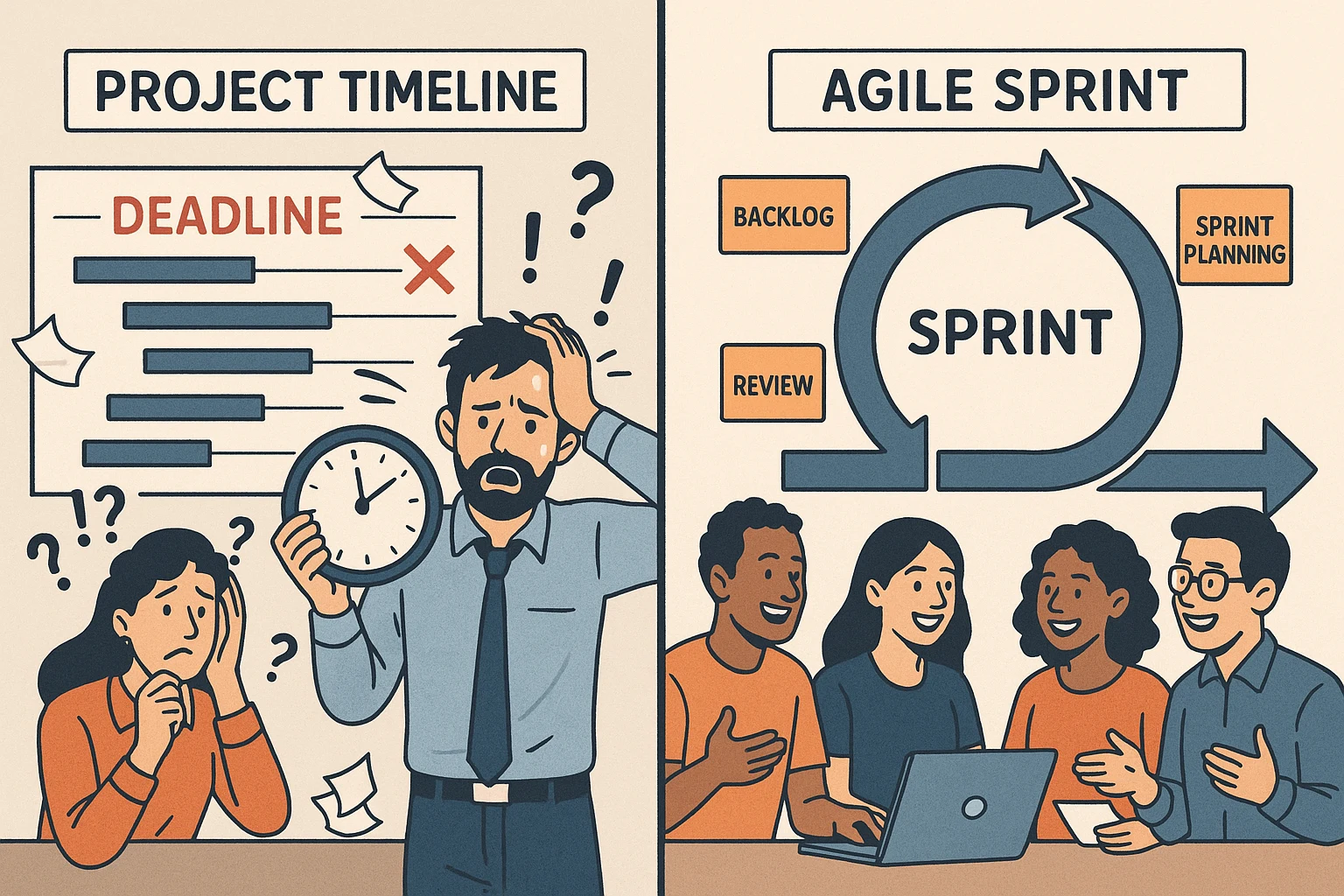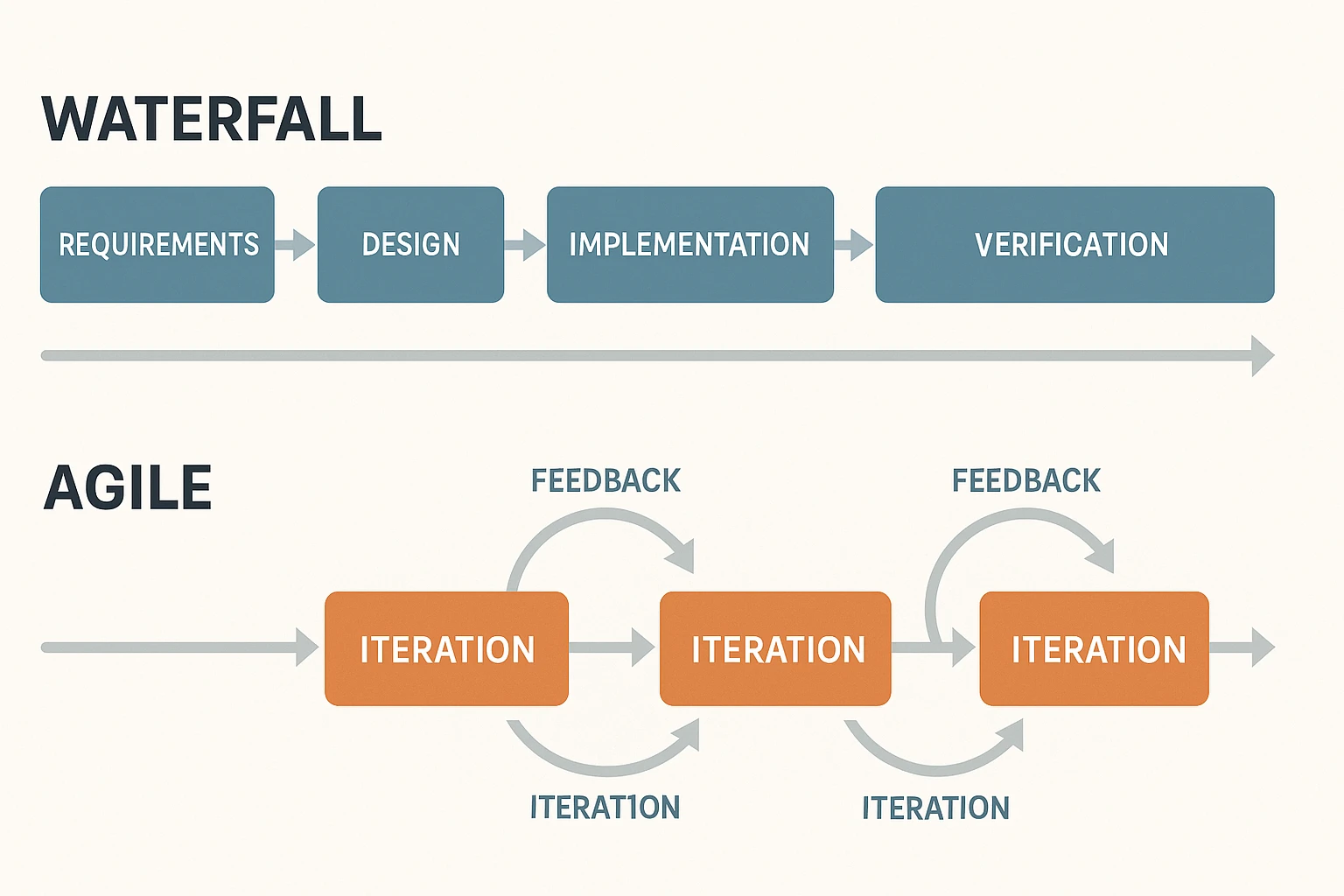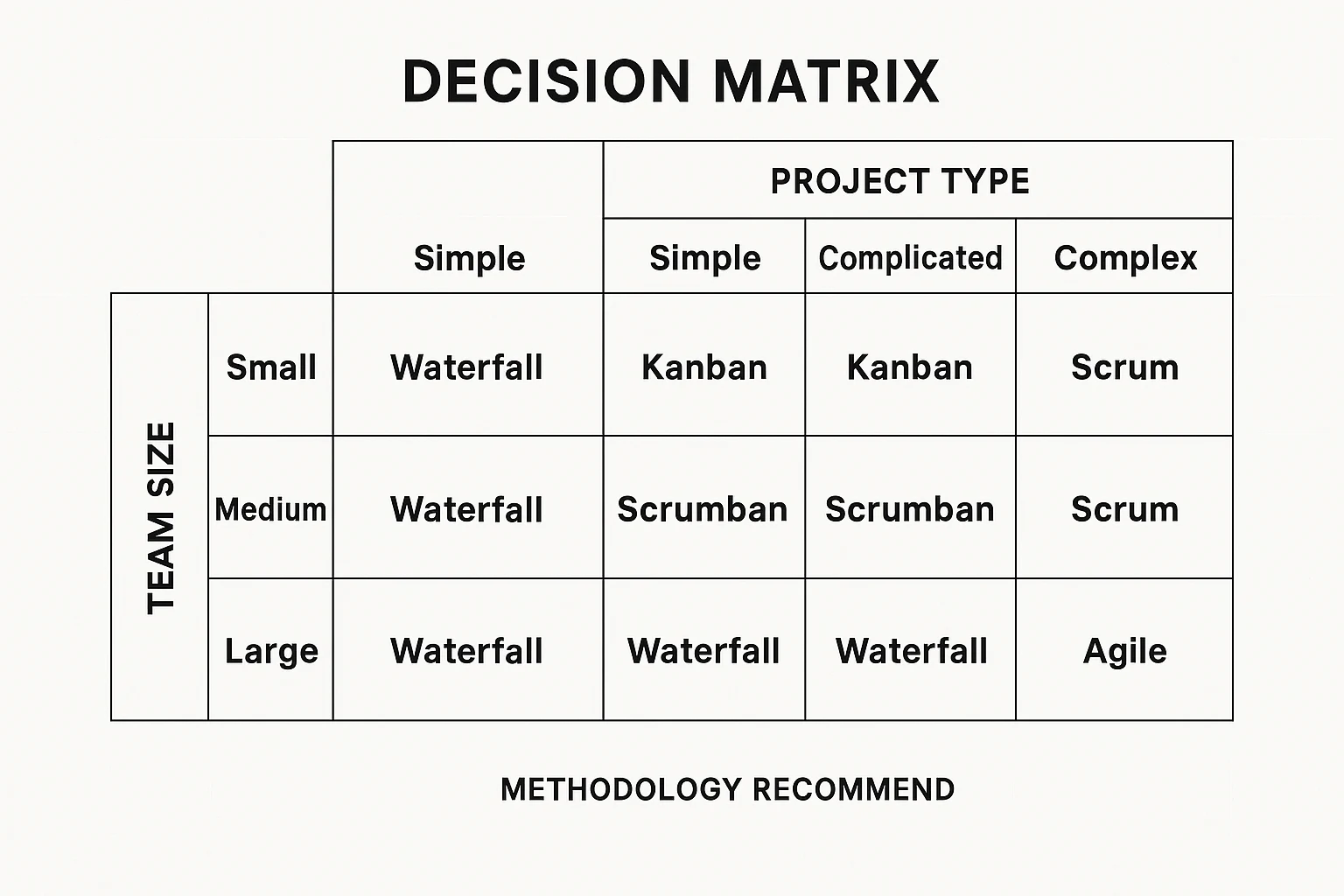Home > software_development > Agile Methodology in Web Development
Agile Methodology in Web Development
Agile represents a fundamental shift in how we think about project management and software development.
By :Thomas Inyang🕒 27 May 2025

Introduction
You are three months into a web development project, and the client keeps changing requirements. Your team is frustrated, deadlines are slipping, and you're wondering if there's a better way to manage projects. Sound familiar?
Well, you're not alone. In 2024, research by the Project Management Institute revealed that 71% of organizations use Agile approaches, yet many teams still struggle with the implementation of project(s) features. So if you are a developer trying to understand what your project manager means by "sprint planning," a business owner evaluating methodologies, or a student preparing for the job market, this guide will transform your understanding of Agile methodology.
By the end of this comprehensive guide, you'll understand the following:
- What is Agile methodology in web development?
- How to implement Agile methodology in your projects.
- Practical insights that typical Agile resources don't provide.
- Real-world application strategies that actually work.

What is Agile Methodology
It is an iterative, people-focused approach to software development that emphasizes collaboration, flexibility, and rapid delivery of working solutions through short development cycles called sprints. See it as using sticker notes on a board that indicates daily meetings.
Agile was created in 2001 when seventeen software developers got together at a Utah ski resort, drawing inspiration from the conventional "waterfall" methodology, which resulted in the Agile Manifesto that prioritizes the following:
- Individuals and interactions over processes and tools.
- Working software over comprehensive documentation.
- Customer collaboration over contract negotiation.
- Responding to change over following a plan.
Here's how the manifesto is applied to web development: instead of spending months planning every detail upfront (and inevitably getting it wrong), Agile teams work in short cycles, gathering feedback and adapting continuously.
See Also: What You Need to Know About NodeJS for Backend Development.
Consider a freelance web developer who switched to Agile last year, spending weeks creating detailed specifications for client websites, only to have clients request major changes after seeing the first version. Now, the freelancer has to work in two-week sprints, showing clients working prototypes every fortnight. Result? The client satisfaction scores increased by 40%, and project completion times dropped by 25%.

This fundamental shift in thinking leads us naturally to understanding how Agile differs from traditional approaches and why this distinction matters for your projects.
Agile vs. Waterfall
Waterfall methodology follows a linear, sequential approach where each phase must be completed before the next begins, while Agile uses iterative cycles that allow for continuous feedback and adaptation. Here is a typical example.
Waterfall excels in projects with fixed requirements and clear endpoints. Think of government contracts, regulatory compliance systems, or projects where changes are costly. If you're building a simple brochure website with clearly defined content and design, waterfall's structured approach might be perfect.
Agile dominates in dynamic environments. E-commerce platforms, SaaS applications, mobile apps, and any project where user feedback drives features benefit enormously from Agile's adaptability.
Here is a real-world example: When creating their customer portal, TechStart Inc. first used waterfall. When they launched after six months of development, they found that users preferred social login features and a mobile-first design, neither of which had been part of the original specs. The waterfall method required a fresh start.
See Also: Database Management System for E-commerce Development.
Agile was used in their second attempt. In just one month, they launched a basic portal, collected user feedback, and iteratively added features that users truly wanted. Three months rather than nine months will pass before the full launch.
The Hybrid Reality: Big businesses frequently use waterfall for budgeting and planning before converting to Agile for development and delivery. This approach, which is sometimes referred to as "Water-Scrum-Fall," blends the best aspects of both methodologies.

Knowing these key distinctions gets us ready to explore Agile's real-world application using its most widely used frameworks.
The Four Pillars of Agile
Each pillar offers a distinct approach to Agile principles: Extreme Programming (technical excellence), Scrum (structured sprints), Kanban (continuous flow), and Lean (waste elimination).
While Agile provides the philosophy, specific methodologies provide the roadmap. Let's explore the four most impactful approaches for web development teams.
Why Scrum
According to the 2024 State of Agile report, 87% of Agile teams use Scrum, making it the most popular Agile adoption. It gives team behavior guidelines through explicit roles, events, and artifacts.
The Scrum Framework:
- Product Owner: Defines what to build based on business value
- Scrum Master: Facilitates the process and removes obstacles
- Development Team: Builds the actual product
Work is done in periods known as sprints, which last one to four weeks. Planning takes place at the start of each sprint, followed by daily check-ins and review and retrospective meetings.
Real-world application: A DevShop agency implements Scrum for all client projects. Their typical two-week sprint includes:
- Monday: Sprint planning (4 hours)
- Tuesday-Thursday: Daily standups (15 minutes each)
- Friday Week 1: Mid-sprint check-in with client
- Friday Week 2: Sprint review and retrospective
This structure reduced their project overruns by 60% and improved client satisfaction scores significantly.
Kanban
Kanban, Japanese for "visual card," focuses on workflow visualization and continuous improvement rather than fixed timeframes.
Core Principles:
- Visualize work using boards (To Do, In Progress, Done)
- Limit work-in-progress to prevent bottlenecks
- Measure and optimize flow continuously
Kanban works exceptionally well for maintenance projects, support teams, and any situation where work arrives unpredictably.
Extreme Programming (XP): Technical Excellence
XP emphasizes technical practices that ensure code quality:
- Pair programming for knowledge sharing.
- Test-driven development for reliability
- Continuous integration for stability
- Simple design for maintainability
While XP's practices seem intensive, teams report 40% fewer bugs and significantly faster feature delivery once implemented.
Lean
Borrowed from manufacturing, Lean focuses on maximizing value while minimizing waste. In web development, this means eliminating unnecessary features, reducing waiting times, and optimizing handoffs between team members.
Every technique has its own advantages, but teams can achieve greater results when they combine methods according to project requirements. The important question that this raises is: how do you decide which strategy is best for your particular circumstance?
Choosing Your Agile Approach
Methodology selection should be based on team size, project complexity, client involvement level, and organizational culture rather than personal preference or industry trends.
Team Size Considerations:
- 2-7 people: Pure Scrum works beautifully with minimal overhead
- 8-15 people: Scrum with some Kanban elements for specialized roles
- 15+ people: Consider scaled frameworks like SAFe or LeSS
Project Characteristics:
- New product development: Scrum's structured sprints provide necessary discipline
- Ongoing maintenance: Kanban's continuous flow handles unpredictable work better
- High-quality requirements: XP's technical practices prevent technical debt
- Resource constraints: Lean's waste elimination maximizes limited resources
High levels of client involvement point to Scrum with frequent evaluations. Clients that work remotely or are less involved frequently favor Kanban's more frequent updates and less structured methodology.
An actual example would be WebCraft Solutions, which caters to both startup and enterprise customers. One-week sprints of pure Scrum are used for startup projects because they require quick iterations and frequent feedback. Enterprise clients utilize a hybrid of Scrum and Kanban, which combines the flexibility of Kanban for managing change requests with the structure of Scrum for planning and delivery.

Now that methodology selection has been discussed, let's look at the useful resources that contribute to successful Agile implementation.
What Are the Essential Agile Tools
The tools range from simple task boards to comprehensive platforms, but the best tool is always the one your team will actually use consistently and effectively.
Project Management Platforms
Jira is the enterprise leader. With its ability to manage intricate workflows, integrate with development tools, and scale to thousands of users, Agile is a better choice. But small teams may find it too complicated.
It works best for teams of ten or more, intricate projects that need thorough reporting, and businesses that already have Atlassian tools.
Trello: Its card-based interface facilitates the easy implementation of Kanban. Its simplicity is both an asset and a drawback; while it works well for simple projects, it is insufficient for more complicated ones.
Azure DevOps: If your development stack runs on Microsoft technologies, Azure DevOps provides seamless integration from planning through deployment.
Development Integration Tools
- GitHub/GitLab: Version control that links commits to user stories
- Slack/Teams: Communication that doesn't interrupt flow
- Confluence: Documentation that stays current with project evolution
See Also: CI/CD Pipeline in Web Development
Tool Selection Strategy
Before choosing tools, answer these questions:
- What's your team's technical comfort level?
- How much customization do you need?
- What are your integration requirements?
- How will clients access project information?
Make it work first. Many teams start with Trello or even physical boards, and as they become more agilely mature, they move on to more advanced tools.
Agile is made possible by tools, but successful implementation necessitates knowing how to get started efficiently.
Your Agile Implementation Roadmap
Adopting Agile successfully requires a methodical process that includes current state assessment, team and tool preparation, pilot project execution, outcome measurement, and gradual scaling based on lessons learned.
Phase 1: Assessment and Preparation (Week 1-2)
Before changing anything, understand where you are. Document:
- How decisions currently get made
- Where delays typically occur
- How client feedback gets incorporated
- What frustrates your team most
Agile requires mindset shifts that some team members embrace more readily than others. Look for:
- Willingness to experiment and learn
- Comfort with frequent client interaction
- Ability to work collaboratively rather than in silos
Phase 2: Pilot Project Selection (Week 3)
Choose your first Agile project carefully. Ideal characteristics:
- Medium complexity (not too simple, not too complex)
- Supportive client willing to provide feedback
- Team members interested in trying Agile
- Flexible timeline that accommodates learning
Phase 3: First Sprint (Week 4-5)
Keep your first sprint simple:
- Two-week duration maximum.
- Clear, achievable goals.
- Daily 15-minute check-ins.
- End with an honest retrospective.
Phase 4: Iteration and Improvement (Ongoing)
Retrospectives, which are organized conversations about what is and is not working, help agile teams get better. Common early enhancements consist of:
- Adjusting sprint length based on team rhythm.
- Refining estimation techniques.
- Enhancing protocols for communicating with clients.
Implementation success depends heavily on avoiding common pitfalls that derail Agile adoption.
Common Pitfalls and How to Avoid Them
Agile implementation failure typically results from treating Agile as a process rather than a mindset, focusing on tools over collaboration, or attempting to scale too quickly without establishing foundational practices.
See Also: How Routing Works in Next.js and React Router
The most common failure mode is implementing Agile ceremonies without embracing Agile principles. Teams hold daily standups that become status reports, conduct sprint planning that's really just task assignment, and run retrospectives that generate no actual changes.
Solution: Focus on outcomes, not activities. Ask, "What problem does this meeting solve?" If you can't answer clearly, reconsider the meeting.
Tool Obsession
Teams often believe that buying the right tool will make them agile. Tools support Agile practices but don't create them.
Real Example: StartupTech spent $50,000 on enterprise Agile tooling for their eight-person team. Six months later, they abandoned the tools and returned to simple Trello boards because the complex tools created more overhead than value.
Scaling Too Fast
Organizations often try to implement Agile across multiple teams simultaneously. This approach overwhelms support systems and dilutes expertise.
Better Approach: Establish Agile excellence in one team first, then use that team as a model and training ground for others.
Ignoring Organizational Culture
Agile demands openness, cooperation, and the ability to view failure as a teaching opportunity. Regardless of the complexity of the methodology, Agile adoption is difficult for organizations with strict hierarchies or blame cultures.
Avoiding these pitfalls positions you for long-term Agile success, but what does that success actually look like in practice?
Conclusion
The key to success is careful implementation that is adapted to your unique circumstances; understanding Agile methodology is only the first step.
To Developers: Start by being familiar with estimation methods and user stories. Develop your ability to translate technical tasks into language that is user-focused. Accept that Agile is a collaborative process; your technical know-how and user input work together to produce better solutions than either one could on its own.
For those in charge of projects: Aim for facilitation rather than control. Your responsibilities change from assigning tasks to removing obstacles. Gain expertise in team coaching and stakeholder communication.
Keep in mind that agile is a process rather than a final goal. There is room for improvement in every team, project, and retrospective. Instead of aiming for flawless procedures, teams that adopt this continuous improvement mindset regularly produce outstanding outcomes.
Please Share.